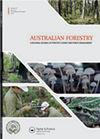Growth of triploid and diploid Acacia clones in three contrasting environments in Viet Nam
IF 1.2
4区 农林科学
Q3 FORESTRY
引用次数: 5
Abstract
ABSTRACT We assessed the growth and adaptability of triploid acacia clones in comparison with commercially planted diploid clones of the same taxa to age three years at three contrasting sites in north, central and south Viet Nam. Application of phosphorus fertiliser at planting gave a growth response only in the trial in central Viet Nam. One triploid Acacia hybrid (Acacia auriculiformis × mangium) clone was constantly the best performer in all sites, achieving mean annual increments at three years of 30.1, 26.6 and 32.1 m3 ha−1 in northern, central and southern Viet Nam, respectively. Two other triploid hybrid clones outperformed the diploid controls in southern Viet Nam. A single triploid A. auriculiformis clone and two diploid clones of this species grew much more slowly. Triploid Acacia hybrid clones had a lower incidence of Corticium salmonicolor (pink disease) and Ceratocystis disease symptoms than did diploid hybrid clones. The wind-firmness of triploid Acacia hybrid clones was comparable with or better than the diploid hybrid clones. Triploid breeding offers a promising new pathway in the development of improved Acacia planting material.越南三倍体和二倍体金合欢无性系在三种不同环境下的生长
摘要在越南北部、中部和南部三个不同的地点,对三倍体金合欢无性系与同一分类群的二倍体商业种植无性系的生长和适应能力进行了比较。在种植时施用磷肥只在越南中部的试验中有生长反应。一个三倍体金合欢杂交种(金合欢× manum)在所有地点的表现都是最好的,在越南北部、中部和南部分别实现了30.1、26.6和32.1 m3 ha - 1的年平均增长量。另外两个三倍体杂交无性系在越南南部的表现优于二倍体对照。一个单一的三倍体auriculformis无性系和两个二倍体无性系的生长速度要慢得多。三倍体金合欢杂交无性系与二倍体杂交无性系相比,出现红粉病和角鼻虫病症状的几率较低。三倍体金合欢杂交无性系的抗风性与二倍体相当或优于二倍体。三倍体育种为金合欢种植材料的改良开发提供了一条有希望的新途径。
本文章由计算机程序翻译,如有差异,请以英文原文为准。
求助全文
约1分钟内获得全文
求助全文
来源期刊

Australian Forestry
FORESTRY-
CiteScore
3.70
自引率
4.80%
发文量
15
审稿时长
>12 weeks
期刊介绍:
Australian Forestry is published by Taylor & Francis for the Institute of Foresters of Australia (IFA) for scientific, technical, and professional communication relating to forestry in the Asia Pacific.
 求助内容:
求助内容: 应助结果提醒方式:
应助结果提醒方式:


